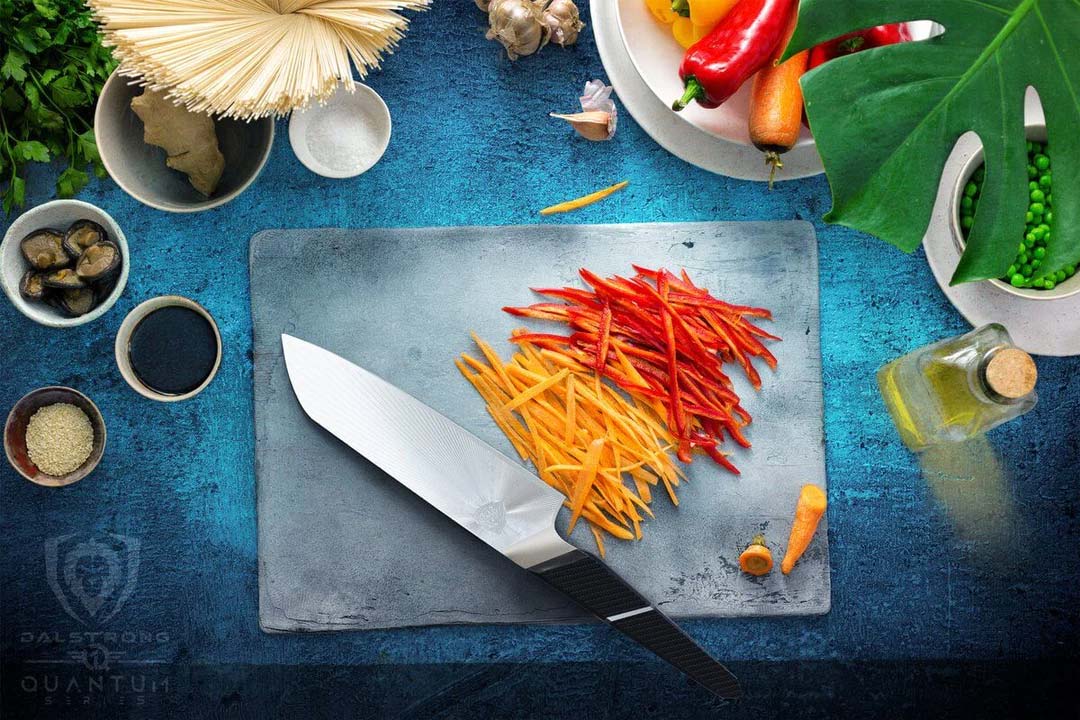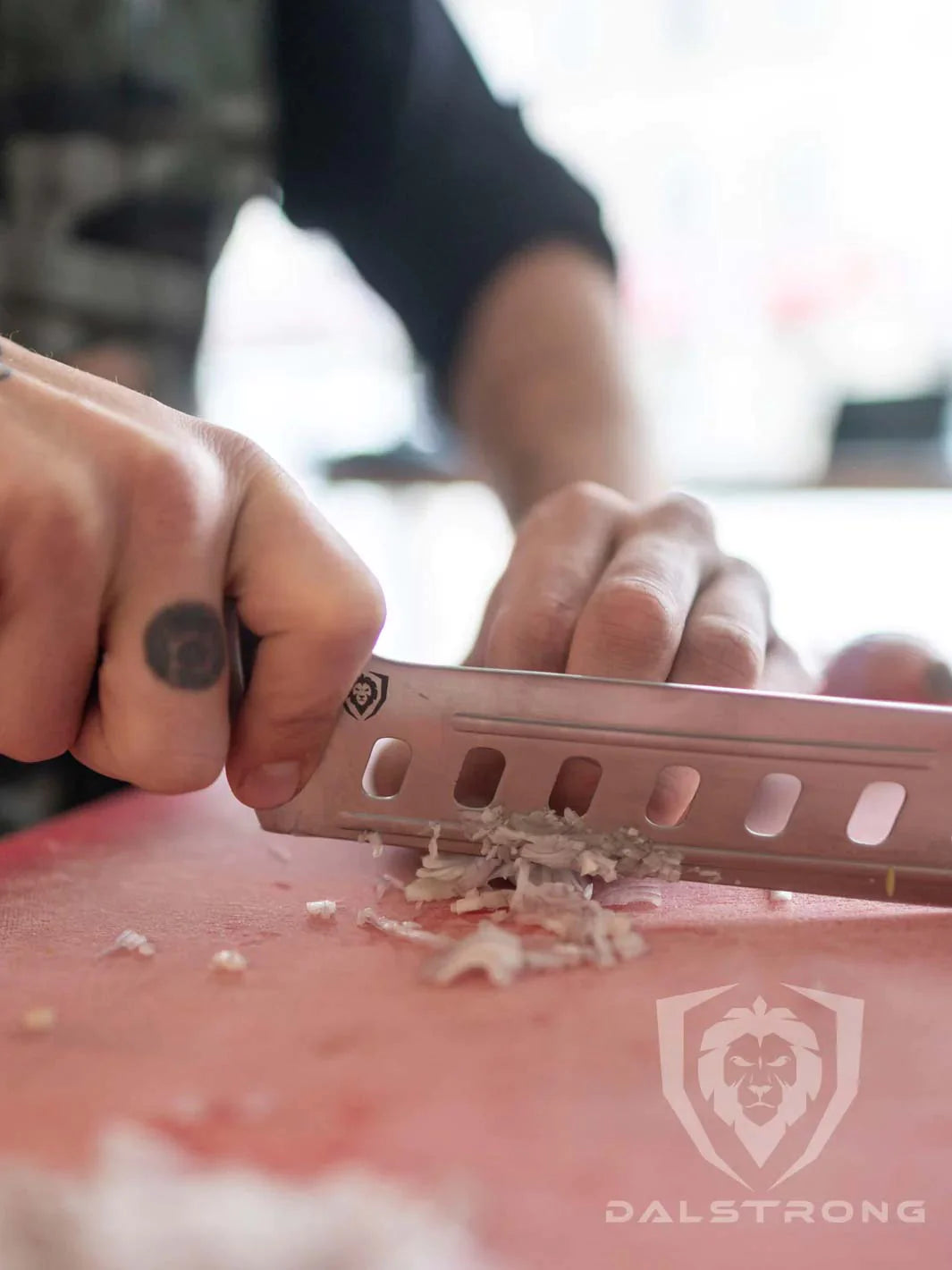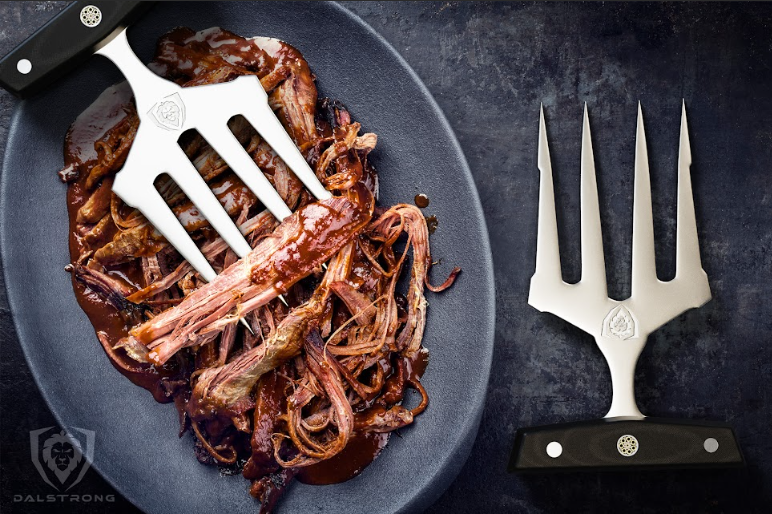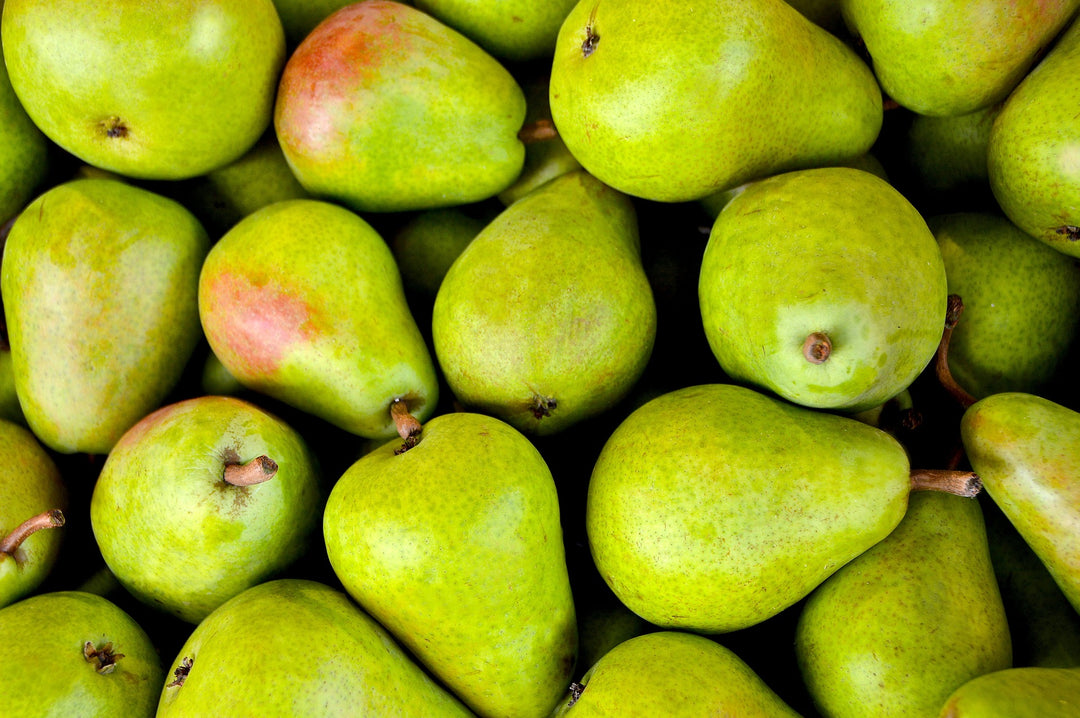How To Oil A Cutting Board For Smooth Slicing
 Dalstrong Teak Wood Corner Board
Dalstrong Teak Wood Corner Board
Quick Overview: How To Oil a Cutting Board
- Clean the cutting board with soapy water and let it dry completely.
- Apply the oil or cream to the board using a clean cloth or paper towel.
- Work the oil to the wood and let it penetrate for 20-30 minutes.
- Wipe and clean off any excess oil with a paper towel.
- Let the board rest for several hours or overnight for the oil to seep into the wood.
- Use a board rest to evenly dry the cutting board.
- Repeat the process every month for the best results.
A cutting board is considered one of the most essential tools in any kitchen, but with regular use, it can become dry, rough, and prone to cracking. This can make it difficult to chop or slice food evenly and can also make the board unsanitary. To maintain a smooth and hygienic cutting surface, oiling your cutting board regularly is essential.
In this article, we'll discuss the benefits of oiling your cutting board and the different types of oils and creams available. So, folks, let’s get right into it.
1. What’s The Purpose of Oiling a Cutting Board?
 Lionswood | Teak Cutting Board | Dalstrong ©
Lionswood | Teak Cutting Board | Dalstrong ©
Oiling your cutting board regularly can help keep it in good condition and ensure a smooth cutting surface. This will help to moisturize the wood, prevent drying out, and protect it from cracks and warping.
Benefits of Oiling a Cutting Board
There are several benefits to oiling your cutting board.
Protects the Board
Oiling your cutting board helps protect the quality of the wood and prevents it from unnecessary moisture, which can lead to wood chipping or cracking. Oiling creates a barrier that prevents moisture from seeping into the wood and helps the board last longer.
Enhances Appearance
Oiling a wooden cutting board or butcher block can enhance its appearance and give it a rich, warm tone. The oil can also help bring out the natural patterns in the wood grain, making it a beautiful addition to your kitchen.
Improves Sanitation
A well-oiled cutting board is less likely to absorb bacteria and other food particles, making it easier to clean and more sanitary.
2. Types of Oils and Creams
 Lionswood- Teak Cutting Board | Dalstrong
Lionswood- Teak Cutting Board | Dalstrong
There are different types of oils and creams available that can be used to oil a cutting board. The most commonly used oils for cutting boards. Such as:
Mineral Oil
Mineral oil is a very popular option for oiling wooden cutting boards because it is odorless, tasteless, and will not go rancid over time. Mineral oil is a petroleum-based product, so some people prefer to use natural oils instead.
Coconut Oil
Coconut oil is a natural alternative to mineral oil and has antimicrobial properties that can help kill bacteria on your cutting board. It's best to warm up Coconut oil before applying it to your board.
Liquid Paraffin
This is an extremely refined mineral oil that is used in food processing and has similar properties to mineral oil. It is a tasteless and odorless oil that won't go rancid over time.
Board Cream
Board cream is a mixture of beeswax, mineral oil, and sometimes other natural ingredients like lemon oil or vitamin E oil. It's thicker than oil and provides a more robust protective layer. Board cream is particularly useful for butcher blocks or heavily used cutting boards.
3. How To Oil a Cutting Board
 Teak Cutting BoardMedium Size | Dalstrong
Teak Cutting BoardMedium Size | Dalstrong
With regular use, cutting boards can become dry and rough and develop cracks. To prevent cracks and ensure a smooth cutting process, it's crucial to oil your cutting board regularly. Here's a step-by-step guide on how to oil a cutting board.
Steps:
- Clean Your Board. Before you oil your cutting board, make sure it's clean. Use warm water and little soap to wash your cutting boards. Then use a clean dish towel to dry it thoroughly. This will remove any dirt, bacteria, or food particles on the surface of the board.
- Choose Your Oil. There are several types of oils and creams that you can use to oil your cutting board. Mineral oil is a popular and affordable option, while cutting board oil and board cream provide additional protection. Coconut oil is also a natural and food-safe choice.
- Apply the Oil. Once you've chosen your oil, it's time to apply it to your cutting board. Add a tiny amount of oil onto the board and use a clean cloth or a paper towel and spread it evenly on the surface. Always apply the oil to the edges of the board as well. Leave the oil for 20-30 minutes so it can penetrate the wood.
- Wipe Off Excess Oil. Allow enough time for the oil to soak into the wood, then use a clean cloth or paper towel to clean off excess oil. This will prevent the board from feeling greasy or leaving an oily residue on your food.
- Apply a Second Coat (Optional). If your cutting board is dry and hasn't been oiled in a long time, applying a second coat of oil or board cream is a good idea. Follow the same process as before, allowing the oil to penetrate the wood for another 20-30 minutes before wiping off any excess.
- Let the Board Rest. Once you've finished oiling your cutting board, let it rest for several hours or overnight to allow the oil to fully penetrate the wood. You can prop the board up on its side or use a board rest to ensure that it dries evenly.
- Maintain Your Board. To keep your chopping board sturdy and maintain it, it's important to oil it regularly. Depending on how frequently you use your cutting board, you may need to oil it every month or every few months. It's also essential to keep your board clean and dry, as excess moisture can lead to warping or cracking.
4. Expert Tips On Oiling a Cutting Board
 Teak Cutting BoardMedium Size | Dalstrong
Teak Cutting BoardMedium Size | Dalstrong
Here are some helpful pro tips on how you can oil your favorite cutting board.
Use Food Grade Oils
When selecting an oil for your cutting board, it's essential to choose a food-grade oil that is safe to use with food. Mineral oil is a popular choice because it's affordable, odorless, and tasteless. Cutting board oil and board cream are also food-safe options that provide additional protection to your cutting board.
Don't Use Vegetable Oils
While vegetable oils may seem like a natural choice, they are not recommended for oiling cutting boards. These oils can become rancid over time, leaving an unpleasant odor and taste on your board. Additionally, some vegetable oils can also cause the wood to break down and deteriorate more quickly.
Apply Oil Regularly
Oiling your cutting board regularly is key to keeping it in good condition. Depending on how frequently you use your cutting board, you may need to oil it every month or every few months. Regular oiling will prevent the wood from drying out and developing cracks or splits.
Apply the Oil Correctly
When applying oil to your cutting board, be sure to cover the entire surface evenly. Apply the oil to the wood using a paper towel. Allow the oil to soak and penetrate into the wood for 20-30 minutes before wiping off any excess.
Let the Board Rest
Once you've finished oiling your cutting board, let it rest for several hours or overnight to allow the oil to fully penetrate the wood. This will ensure that the board remains protected and prevents the wood from drying out.
Don't Over-Oil Your Board
While it's important to oil your cutting board regularly, it's essential not to overdo it. Over-oiling your board can cause the wood to become saturated, leading to a greasy surface and a buildup of oil. This can also make it difficult to chop food on the board.
Use Paper Towels
When wiping off excess oil, it's best to use paper towels instead of a cloth. Paper towels are more absorbent and will remove excess oil more effectively. Always dispose the used paper towels properly.
Use Edge Grain Cutting Boards
Edge grain cutting boards are more durable and resistant to scratches and knife marks than other types of cutting boards. They also require less maintenance than end grain or plastic cutting boards.
5. Best Dalstrong Cutting Boards For You
1. Cutting Board with Rubberwood Stand – Call of Duty © Edition
This exclusive collector board has made its way onto my top 10 list of Dalstrong products for all the right reasons! This board is laser-etched with a Call of Duty® logo on one side and a topographical terrain pattern on the other, making it perfect for chefs on the move or mid-game snack breaks. Still need some convincing?
Pros:
- Made from premium European Beech wood, a closed-grained hardwood that offers scratch and impact resistance.
- The heavy duty, yet lightweight aluminum alloy handle makes it easy to transport.
- The black rubberwood stand is space-saving and makes it easy to store.
Cons:
- The board may require more maintenance than other materials, as wood needs to be regularly oiled to maintain its quality.
- If you're not a gamer, you may not appreciate how awesome this board is.
2. Dalstrong Series Infinity Series Wood- Fibre Cutting Board - Medium - Obsidian Black
The Dalstrong Infinity Series cutting board is a chef's ally in the kitchen, crafted with premium wood-fiber engineering and designed in sleek Obsidian Black. Made of eco-friendly wood-fiber composite, it is more functional and practical than poly, glass, and wood cutting boards.
Pros:
- Premium wood-fiber engineering and eco-friendly composite material make it more practical and functional than other cutting boards.
- It is smooth and non-porous, making it dishwasher-safe and easy to clean.
- Non-slip silicone feet provide stability and safety during rigorous cutting action.
Cons:
- This board may require more upkeep than some other cutting board materials.
- The sleek appearance and modern design of the board may not appeal to home cooks who prefer a more traditional or rustic look in their kitchen.
3. Lionswood Teak Cutting Board | Medium Size | Dalstrong ©
This Dalstrong Teak Cutting Board is an all-purpose board made from sustainably sourced Tropical Teak wood and is meticulously hand-crafted from end-grain wood. The show-stopping checkered design has a slip-resistant surface which is ideal for resisting impact and ensuring your Dalstrong knives stay sharper and longer.
Pros:
- Designed two steel handles, making it easy to carry and double as a serving board.
- Features a curved cut-out on the underside of the board to house a side plate for easy scraping and transferring of ingredients.
- Easy to clean and maintain.
Cons:
- It may require regular oiling and maintenance to prevent drying out or cracking over time.
- The steel handles may become hot to the touch when exposed to high temperatures, potentially making it difficult to handle.
4. Teak Cutting Board Large Size | Horizontal Grain | Dalstrong ©
This Teak wood chopping board is simply perfect, thanks to its ideal size, for larger everyday chopping and cutting tasks. Made of 100% sustainably sourced Tropical Teak wood, this cutting board is very durable and will also age beautifully. The board's lasered measurement lines on the bottom provide easy and precise cuts, while its long juice groove helps keep messy prep on the board and off your counter.
Pros:
- Large size perfect for everyday chopping and cutting tasks, measuring 22" x 15"
- It features lasered measurement lines on the bottom of the board which allows precise cuts.
- Adorned with 2 Dalstrong Lion Head Pins and laser-etched with the Dalstrong logo.
Cons:
- Requires regular oiling and maintenance to keep the wood from drying out or cracking over time
- Good be quite large for folks with compact kitchens.
5. Corner Cutting Board - Teak Wood Dalstrong ©
The Dalstrong Corner Teak Cutting Board is a cleverly designed kitchen tool that reclaims space where you need it most. With its shield-like design and stabilizing corner block, it fits snugly into the inner corner of your countertop, adding a stylish element to your kitchen.
Pros:
- Clever space-saving design that fits snugly into the inner corner of your countertop.
- Checkered construction for impact absorption, making it slip-resistant and durable.
- A low-maintenance surface that only gets more beautiful with age.
Cons:
- It may not be ideal for larger cutting and chopping tasks due to its compact size.
- Not intended for hot surfaces, so it cannot be used for placing hot pots and pans.
6. Frequently Added Questions
What is the best way to oil a cutting board?
To oil your cutting board, apply food-grade mineral oil generously, let it soak for several minutes, then wipe off excess oil and let it dry completely.
What is the best oil for wood cutting boards?
Food-grade mineral oil is the best oil for wood chopping boards.
Can I use olive oil to oil my cutting board?
Unfortunately, using olive oil to oil a cutting board is not recommended as it can go rancid and leave a sticky residue on the board over time.
Can you use vegetable oil to seal a cutting board?
Yes, vegetable oil can be used to seal a cutting board, but there are better choices than this, as it can go rancid over time and leave an unpleasant taste and smell on the board. Food-grade mineral oil or specialized cutting board oils are better options for sealing a cutting board.
Shop Dalstrong Cutting Boards Today!
Written by Ananya Tiwari



















































































































































































































































